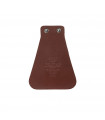This Mud Flap is an essential accessory for bicycle fenders to greatly reduce the amount of overspray, keeping shoes and trousers clean.
Inspired by the design of the 1937 mudguard flap, our new mud flap is made of the same leather used for Brooks Saddles. It is provided with 2 screw bolts to fix it on the mudguard.
Vegetable tanned leather
Color: brown






Leave a review